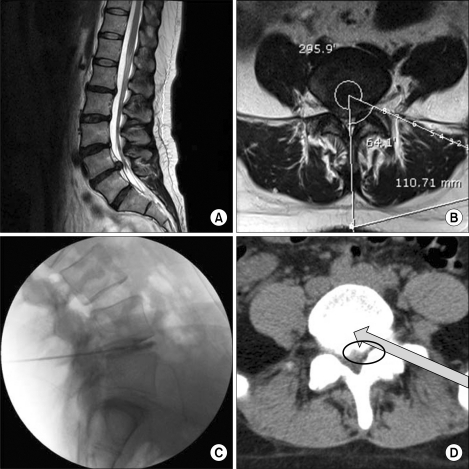Use of Lidocaine Patch for Percutaneous Endoscopic Lumbar Discectomy
- Affiliations
-
- 1Department of Anesthesia and Pain Medicine, School of Medicine, Pusan National University, Yangsan, Korea. pain@pusan.ac.kr
- KMID: 2074001
- DOI: http://doi.org/10.3344/kjp.2011.24.2.74
Abstract
- BACKGROUND
Lidocaine patch (L5P) has demonstrated short-term efficacy in treating both acute surgical pain and chronic neuropathic pain with tolerable side effects. Percutaneous endoscopic lumbar discectomy (PELD) is the mainstay of minimally invasive spine surgery (MISS). Sufficient analgesia during PELD surgery makes the patient consider it real MISS. This study was performed to evaluate the efficacy and adverse effects of lidocaine patch in patients who underwent PELD under local anesthesia.
METHODS
L5P (L group) or placebo (P group) was randomly applied on the skin of the back covering the anticipated path of the working channel before 1 hour of surgery in 100 patients who underwent a single level PELD at L4-L5. Efficacy of the lidocaine patch was assessed by patient's numeric rating scale (NRS) of pain at each stage during the surgery and by a 5-scale grading of the satisfaction with the anesthesia of the operator and patients after surgery.
RESULTS
Mean NRS scores at the stages of needle insertion, skin incision, serial dilation and insertion of working channel, and subcutaneous suture were significantly lower in the L group than the P group. Postoperative operator's and patients' satisfaction scores were also significantly higher in L group than in the P group. There were subtle adverse effects in both groups.
CONCLUSIONS
L5P provided better pain relief during PELD, especially at the stage of needle insertion, skin incision, serial dilation and insertion of working channel, and subcutaneous suture. It also provided higher patient and operator postoperative satisfaction, with only subtle adverse effects.
MeSH Terms
Figure
Cited by 5 articles
-
Topical agents: a thoughtful choice for multimodal analgesia
Eunjoo Choi, Francis Sahngun Nahm, Woong Ki Han, Pyung-Bok Lee, Jihun Jo
Korean J Anesthesiol. 2020;73(5):384-393. doi: 10.4097/kja.20357.Evaluation of an Experimentally Designed Stereotactic Guidance System for Determining Needle Entry Point during Uniplanar Fluoroscopy-guided Intervention
Jae Heon Lee, Gye Rok Jeon, Jung Hoon Ro, Gyeong Jo Byoen, Tae Kyun Kim, Kyung Hoon Kim
Korean J Pain. 2012;25(2):81-88. doi: 10.3344/kjp.2012.25.2.81.Safe Sedation and Hypnosis using Dexmedetomidine for Minimally Invasive Spine Surgery in a Prone Position
Kyung Hoon Kim
Korean J Pain. 2014;27(4):313-320. doi: 10.3344/kjp.2014.27.4.313.Nefopam Reduces Dysesthesia after Percutaneous Endoscopic Lumbar Discectomy
Young Min Ok, Ji Hyun Cheon, Eun Ji Choi, Eun Jung Chang, Ho Myung Lee, Kyung Hoon Kim
Korean J Pain. 2016;29(1):40-47. doi: 10.3344/kjp.2016.29.1.40.A Modified Approach of Percutaneous Endoscopic Lumbar Discectomy (PELD) for Far Lateral Disc Herniation at L5-S1 with Foot Drop
Eun Hee Chun, Hahck Soo Park
Korean J Pain. 2016;29(1):57-61. doi: 10.3344/kjp.2016.29.1.57.
Reference
-
1. Rowbotham MC, Davies PS, Verkempinck C, Galer BS. Lidocaine patch: double-blind controlled study of a new treatment method for post-herpetic neuralgia. Pain. 1996; 65:39–44. PMID: 8826488.
Article2. Moon JY, Choi JB, Lee PB, Son HM, Nam FS, Kim YC, et al. An open-label trial of the 5% lidocaine patches for the treatment of chronic pain. Korean J Pain. 2009; 22:216–223.
Article3. Curry SE, Finkel JC. Use of the Synera patch for local anesthesia before vascular access procedures: a randomized, double-blind, placebo-controlled study. Pain Med. 2007; 8:497–502. PMID: 17716323.
Article4. Schecter AK, Pariser DM, Pariser RJ, Ling MR, Stewart D, Sadick NS. Randomized, double-blind, placebo-controlled study evaluating the lidocaine/tetracaine patch for induction of local anesthesia prior to minor dermatologic procedures in geriatric patients. Dermatol Surg. 2005; 31:287–291. PMID: 15841628.
Article5. Tsou PM, Alan Yeung C, Yeung AT. Posterolateral transforaminal selective endoscopic discectomy and thermal annuloplasty for chronic lumbar discogenic pain: a minimal access visualized intradiscal surgical procedure. Spine J. 2004; 4:564–573. PMID: 15363430.
Article6. Kim KH. Posterolateral percutaneous endoscopic lumbar discectomy. Korean J Pain. 2004; 17(Suppl):5–12.
Article7. Moeller TB, Reif E. Pocket atlas of sectional anatomy. Volume 3 spine, extremities, joints. 2007. Stuttgart: Thieme;p. 310–311.8. Ross LM, Lamperti ED. Atlas of anatomy. General anatomy and musculoskeletal system. 2006. Stuttgart: Thieme;p. 138–141.9. Freeman R. The treatment of neuropathic pain. CNS Spectr. 2005; 10:698–706. PMID: 16142210.
Article10. Kern KU, Kohl M, Kiefer RT. Lidocaine patch for therapy of neuropathic and non-neuropathic pain. A clinical case series of 87 patients. Nervenarzt. 2010; 81:1490–1497. PMID: 20577706.
Article11. Kanai A, Suzuki A, Okamoto H. Comparison of cutaneous anesthetic effect of 8% lidocaine spray with lidocaine patch using current perception threshold test. Pain Med. 2010; 11:472–475. PMID: 20113414.
Article12. Lavand'homme P. Perioperative pain. Curr Opin Anaesthesiol. 2006; 19:556–561. PMID: 16960491.
- Full Text Links
- Actions
-
Cited
- CITED
-
- Close
- Share
- Similar articles
-
- Evolution of Percutaneous Endoscopic Lumbar Decompression
- Percutaneous Endoscopic Discectomy for Lumbar Disc Herniation
- Percutaneous Endoscopic Lumbar Discectomy (PELD)
- Clinical Analysis of the Automated Percutaneous Discectomy
- Clinical Results of Percutaneous Endoscopic Discectomy in Herniated Intervertebral disc of Lumbar Spine


